Critical Appraisal of Paper
VerifiedAdded on 2023/04/08
|12
|2513
|333
AI Summary
This critical appraisal examines a research paper on the perceptions of occupational therapists and physiotherapists regarding risk with older adults in acute care settings. The study used a qualitative methodology, including a focus group interview, to gather data. The researchers justified their resear...
Read More
Contribute Materials
Your contribution can guide someone’s learning journey. Share your
documents today.

Running head: CRITICAL APPRAISAL OF PAPER
Critical Appraisal
Name of the Student
Name of the University
Author Note
Critical Appraisal
Name of the Student
Name of the University
Author Note
Secure Best Marks with AI Grader
Need help grading? Try our AI Grader for instant feedback on your assignments.
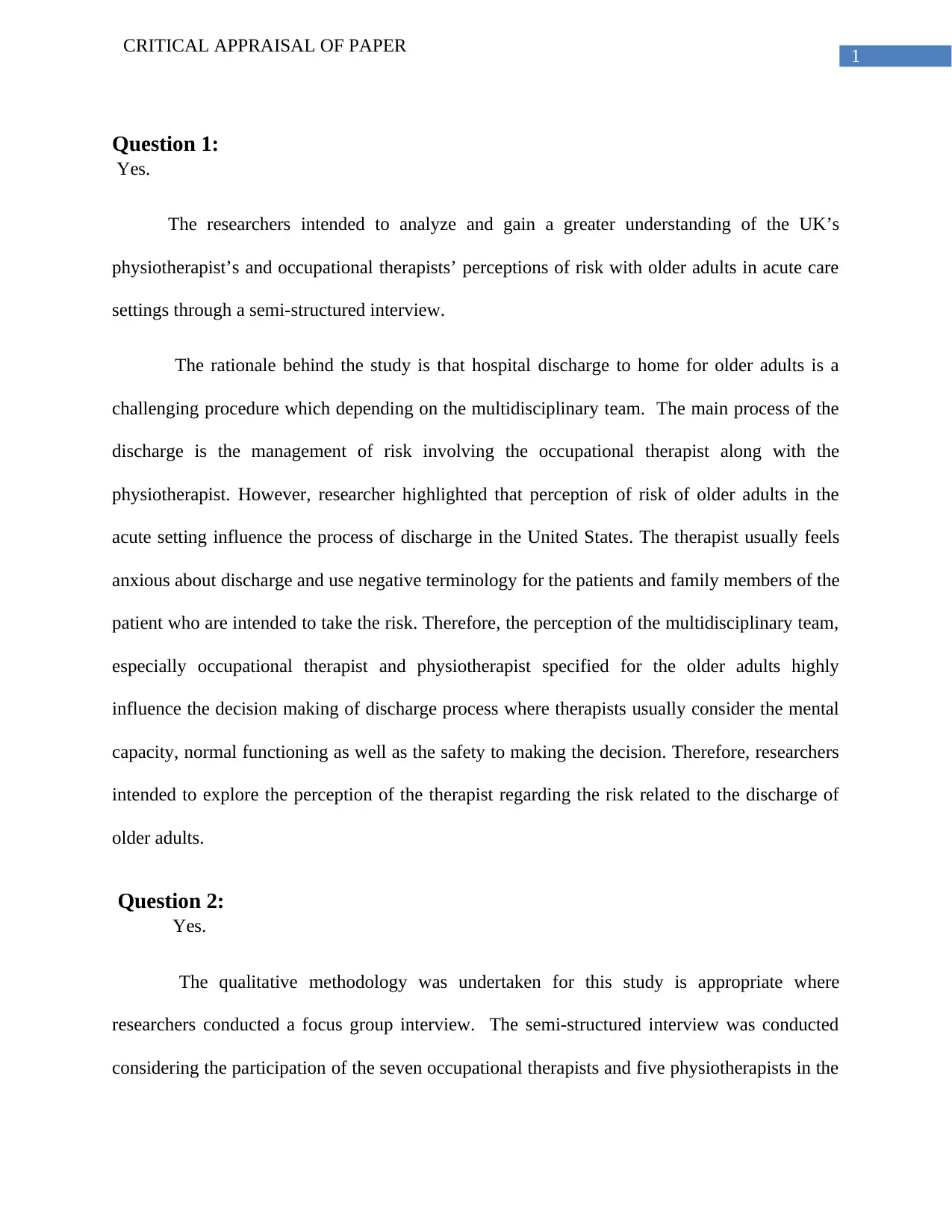
1
CRITICAL APPRAISAL OF PAPER
Question 1:
Yes.
The researchers intended to analyze and gain a greater understanding of the UK’s
physiotherapist’s and occupational therapists’ perceptions of risk with older adults in acute care
settings through a semi-structured interview.
The rationale behind the study is that hospital discharge to home for older adults is a
challenging procedure which depending on the multidisciplinary team. The main process of the
discharge is the management of risk involving the occupational therapist along with the
physiotherapist. However, researcher highlighted that perception of risk of older adults in the
acute setting influence the process of discharge in the United States. The therapist usually feels
anxious about discharge and use negative terminology for the patients and family members of the
patient who are intended to take the risk. Therefore, the perception of the multidisciplinary team,
especially occupational therapist and physiotherapist specified for the older adults highly
influence the decision making of discharge process where therapists usually consider the mental
capacity, normal functioning as well as the safety to making the decision. Therefore, researchers
intended to explore the perception of the therapist regarding the risk related to the discharge of
older adults.
Question 2:
Yes.
The qualitative methodology was undertaken for this study is appropriate where
researchers conducted a focus group interview. The semi-structured interview was conducted
considering the participation of the seven occupational therapists and five physiotherapists in the
CRITICAL APPRAISAL OF PAPER
Question 1:
Yes.
The researchers intended to analyze and gain a greater understanding of the UK’s
physiotherapist’s and occupational therapists’ perceptions of risk with older adults in acute care
settings through a semi-structured interview.
The rationale behind the study is that hospital discharge to home for older adults is a
challenging procedure which depending on the multidisciplinary team. The main process of the
discharge is the management of risk involving the occupational therapist along with the
physiotherapist. However, researcher highlighted that perception of risk of older adults in the
acute setting influence the process of discharge in the United States. The therapist usually feels
anxious about discharge and use negative terminology for the patients and family members of the
patient who are intended to take the risk. Therefore, the perception of the multidisciplinary team,
especially occupational therapist and physiotherapist specified for the older adults highly
influence the decision making of discharge process where therapists usually consider the mental
capacity, normal functioning as well as the safety to making the decision. Therefore, researchers
intended to explore the perception of the therapist regarding the risk related to the discharge of
older adults.
Question 2:
Yes.
The qualitative methodology was undertaken for this study is appropriate where
researchers conducted a focus group interview. The semi-structured interview was conducted
considering the participation of the seven occupational therapists and five physiotherapists in the
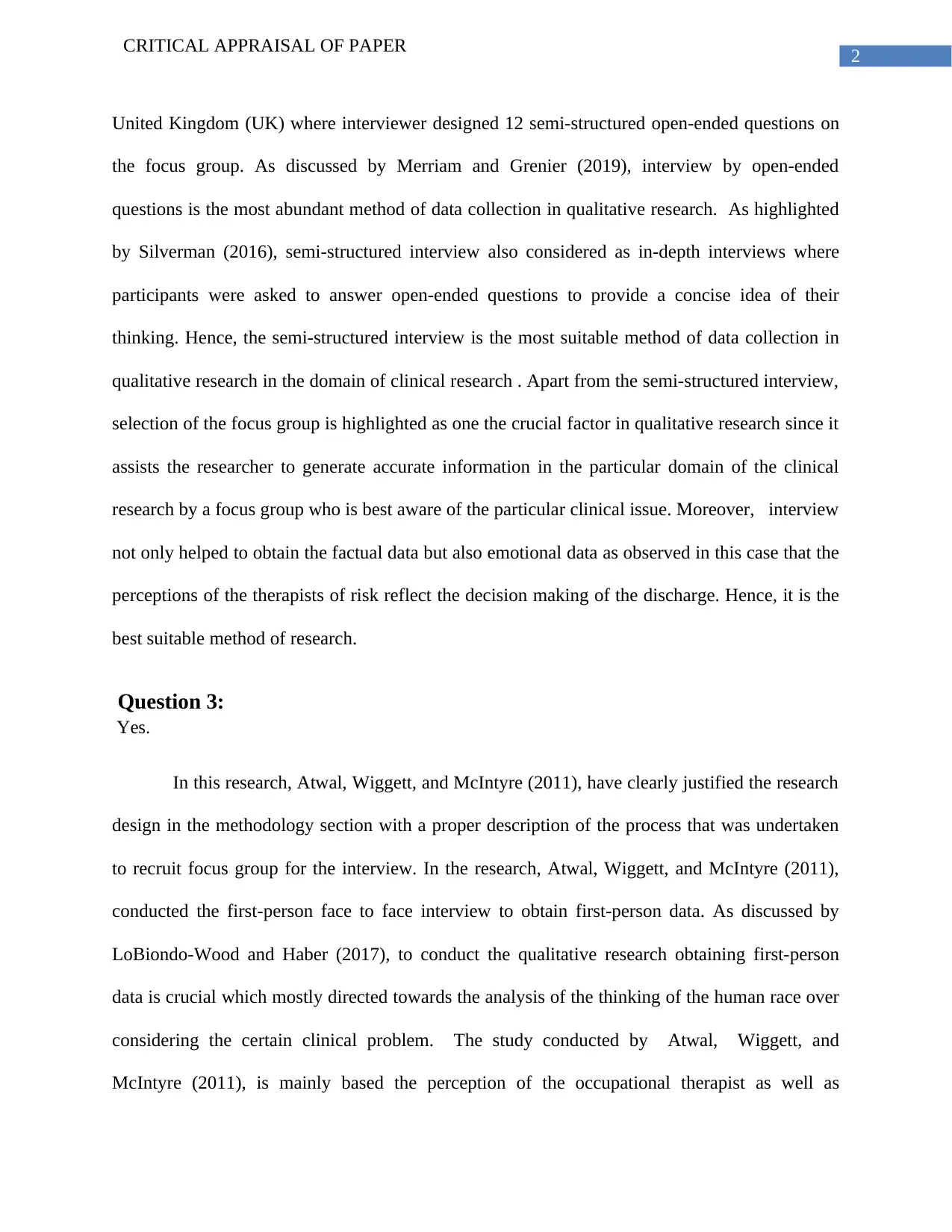
2
CRITICAL APPRAISAL OF PAPER
United Kingdom (UK) where interviewer designed 12 semi-structured open-ended questions on
the focus group. As discussed by Merriam and Grenier (2019), interview by open-ended
questions is the most abundant method of data collection in qualitative research. As highlighted
by Silverman (2016), semi-structured interview also considered as in-depth interviews where
participants were asked to answer open-ended questions to provide a concise idea of their
thinking. Hence, the semi-structured interview is the most suitable method of data collection in
qualitative research in the domain of clinical research . Apart from the semi-structured interview,
selection of the focus group is highlighted as one the crucial factor in qualitative research since it
assists the researcher to generate accurate information in the particular domain of the clinical
research by a focus group who is best aware of the particular clinical issue. Moreover, interview
not only helped to obtain the factual data but also emotional data as observed in this case that the
perceptions of the therapists of risk reflect the decision making of the discharge. Hence, it is the
best suitable method of research.
Question 3:
Yes.
In this research, Atwal, Wiggett, and McIntyre (2011), have clearly justified the research
design in the methodology section with a proper description of the process that was undertaken
to recruit focus group for the interview. In the research, Atwal, Wiggett, and McIntyre (2011),
conducted the first-person face to face interview to obtain first-person data. As discussed by
LoBiondo-Wood and Haber (2017), to conduct the qualitative research obtaining first-person
data is crucial which mostly directed towards the analysis of the thinking of the human race over
considering the certain clinical problem. The study conducted by Atwal, Wiggett, and
McIntyre (2011), is mainly based the perception of the occupational therapist as well as
CRITICAL APPRAISAL OF PAPER
United Kingdom (UK) where interviewer designed 12 semi-structured open-ended questions on
the focus group. As discussed by Merriam and Grenier (2019), interview by open-ended
questions is the most abundant method of data collection in qualitative research. As highlighted
by Silverman (2016), semi-structured interview also considered as in-depth interviews where
participants were asked to answer open-ended questions to provide a concise idea of their
thinking. Hence, the semi-structured interview is the most suitable method of data collection in
qualitative research in the domain of clinical research . Apart from the semi-structured interview,
selection of the focus group is highlighted as one the crucial factor in qualitative research since it
assists the researcher to generate accurate information in the particular domain of the clinical
research by a focus group who is best aware of the particular clinical issue. Moreover, interview
not only helped to obtain the factual data but also emotional data as observed in this case that the
perceptions of the therapists of risk reflect the decision making of the discharge. Hence, it is the
best suitable method of research.
Question 3:
Yes.
In this research, Atwal, Wiggett, and McIntyre (2011), have clearly justified the research
design in the methodology section with a proper description of the process that was undertaken
to recruit focus group for the interview. In the research, Atwal, Wiggett, and McIntyre (2011),
conducted the first-person face to face interview to obtain first-person data. As discussed by
LoBiondo-Wood and Haber (2017), to conduct the qualitative research obtaining first-person
data is crucial which mostly directed towards the analysis of the thinking of the human race over
considering the certain clinical problem. The study conducted by Atwal, Wiggett, and
McIntyre (2011), is mainly based the perception of the occupational therapist as well as
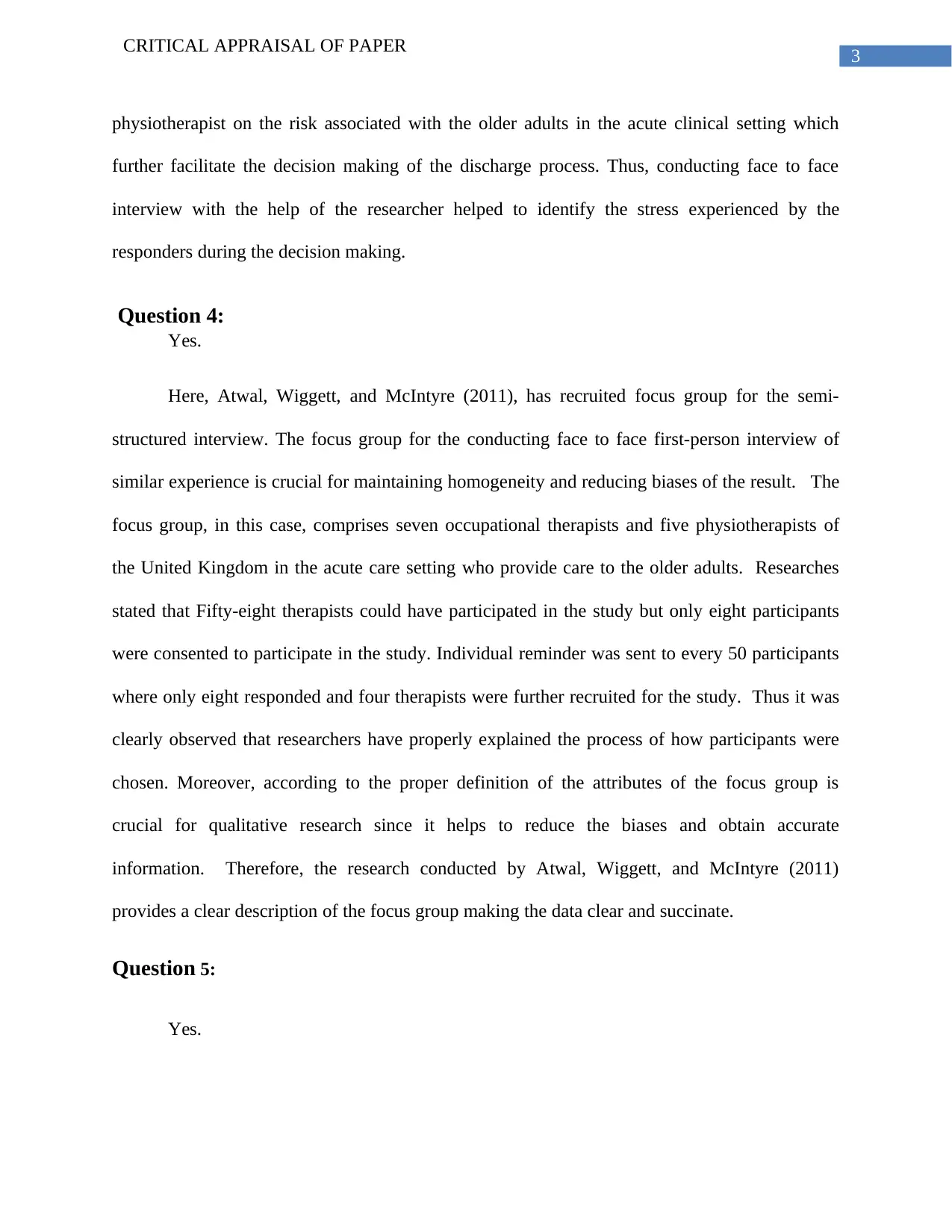
3
CRITICAL APPRAISAL OF PAPER
physiotherapist on the risk associated with the older adults in the acute clinical setting which
further facilitate the decision making of the discharge process. Thus, conducting face to face
interview with the help of the researcher helped to identify the stress experienced by the
responders during the decision making.
Question 4:
Yes.
Here, Atwal, Wiggett, and McIntyre (2011), has recruited focus group for the semi-
structured interview. The focus group for the conducting face to face first-person interview of
similar experience is crucial for maintaining homogeneity and reducing biases of the result. The
focus group, in this case, comprises seven occupational therapists and five physiotherapists of
the United Kingdom in the acute care setting who provide care to the older adults. Researches
stated that Fifty-eight therapists could have participated in the study but only eight participants
were consented to participate in the study. Individual reminder was sent to every 50 participants
where only eight responded and four therapists were further recruited for the study. Thus it was
clearly observed that researchers have properly explained the process of how participants were
chosen. Moreover, according to the proper definition of the attributes of the focus group is
crucial for qualitative research since it helps to reduce the biases and obtain accurate
information. Therefore, the research conducted by Atwal, Wiggett, and McIntyre (2011)
provides a clear description of the focus group making the data clear and succinate.
Question 5:
Yes.
CRITICAL APPRAISAL OF PAPER
physiotherapist on the risk associated with the older adults in the acute clinical setting which
further facilitate the decision making of the discharge process. Thus, conducting face to face
interview with the help of the researcher helped to identify the stress experienced by the
responders during the decision making.
Question 4:
Yes.
Here, Atwal, Wiggett, and McIntyre (2011), has recruited focus group for the semi-
structured interview. The focus group for the conducting face to face first-person interview of
similar experience is crucial for maintaining homogeneity and reducing biases of the result. The
focus group, in this case, comprises seven occupational therapists and five physiotherapists of
the United Kingdom in the acute care setting who provide care to the older adults. Researches
stated that Fifty-eight therapists could have participated in the study but only eight participants
were consented to participate in the study. Individual reminder was sent to every 50 participants
where only eight responded and four therapists were further recruited for the study. Thus it was
clearly observed that researchers have properly explained the process of how participants were
chosen. Moreover, according to the proper definition of the attributes of the focus group is
crucial for qualitative research since it helps to reduce the biases and obtain accurate
information. Therefore, the research conducted by Atwal, Wiggett, and McIntyre (2011)
provides a clear description of the focus group making the data clear and succinate.
Question 5:
Yes.
Secure Best Marks with AI Grader
Need help grading? Try our AI Grader for instant feedback on your assignments.
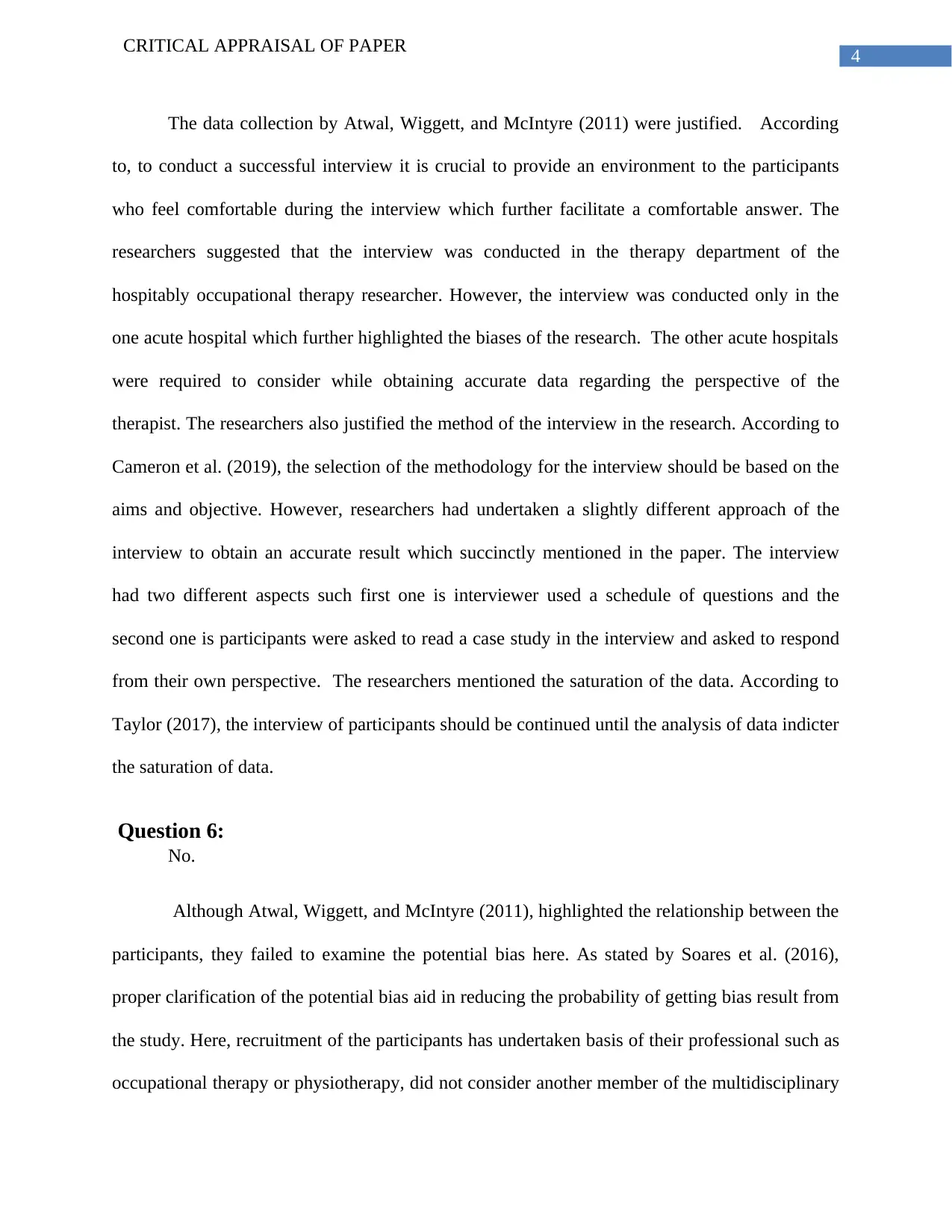
4
CRITICAL APPRAISAL OF PAPER
The data collection by Atwal, Wiggett, and McIntyre (2011) were justified. According
to, to conduct a successful interview it is crucial to provide an environment to the participants
who feel comfortable during the interview which further facilitate a comfortable answer. The
researchers suggested that the interview was conducted in the therapy department of the
hospitably occupational therapy researcher. However, the interview was conducted only in the
one acute hospital which further highlighted the biases of the research. The other acute hospitals
were required to consider while obtaining accurate data regarding the perspective of the
therapist. The researchers also justified the method of the interview in the research. According to
Cameron et al. (2019), the selection of the methodology for the interview should be based on the
aims and objective. However, researchers had undertaken a slightly different approach of the
interview to obtain an accurate result which succinctly mentioned in the paper. The interview
had two different aspects such first one is interviewer used a schedule of questions and the
second one is participants were asked to read a case study in the interview and asked to respond
from their own perspective. The researchers mentioned the saturation of the data. According to
Taylor (2017), the interview of participants should be continued until the analysis of data indicter
the saturation of data.
Question 6:
No.
Although Atwal, Wiggett, and McIntyre (2011), highlighted the relationship between the
participants, they failed to examine the potential bias here. As stated by Soares et al. (2016),
proper clarification of the potential bias aid in reducing the probability of getting bias result from
the study. Here, recruitment of the participants has undertaken basis of their professional such as
occupational therapy or physiotherapy, did not consider another member of the multidisciplinary
CRITICAL APPRAISAL OF PAPER
The data collection by Atwal, Wiggett, and McIntyre (2011) were justified. According
to, to conduct a successful interview it is crucial to provide an environment to the participants
who feel comfortable during the interview which further facilitate a comfortable answer. The
researchers suggested that the interview was conducted in the therapy department of the
hospitably occupational therapy researcher. However, the interview was conducted only in the
one acute hospital which further highlighted the biases of the research. The other acute hospitals
were required to consider while obtaining accurate data regarding the perspective of the
therapist. The researchers also justified the method of the interview in the research. According to
Cameron et al. (2019), the selection of the methodology for the interview should be based on the
aims and objective. However, researchers had undertaken a slightly different approach of the
interview to obtain an accurate result which succinctly mentioned in the paper. The interview
had two different aspects such first one is interviewer used a schedule of questions and the
second one is participants were asked to read a case study in the interview and asked to respond
from their own perspective. The researchers mentioned the saturation of the data. According to
Taylor (2017), the interview of participants should be continued until the analysis of data indicter
the saturation of data.
Question 6:
No.
Although Atwal, Wiggett, and McIntyre (2011), highlighted the relationship between the
participants, they failed to examine the potential bias here. As stated by Soares et al. (2016),
proper clarification of the potential bias aid in reducing the probability of getting bias result from
the study. Here, recruitment of the participants has undertaken basis of their professional such as
occupational therapy or physiotherapy, did not consider another member of the multidisciplinary
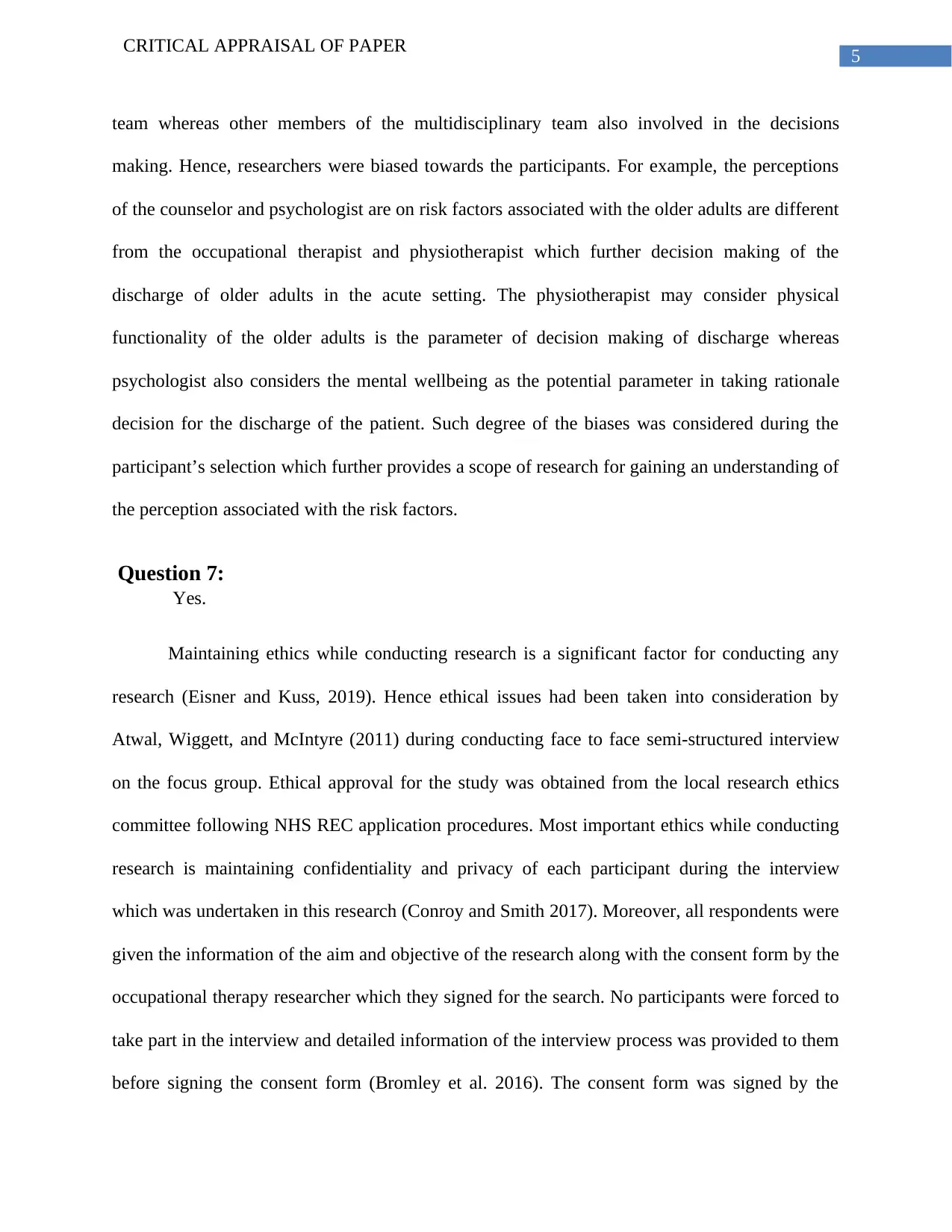
5
CRITICAL APPRAISAL OF PAPER
team whereas other members of the multidisciplinary team also involved in the decisions
making. Hence, researchers were biased towards the participants. For example, the perceptions
of the counselor and psychologist are on risk factors associated with the older adults are different
from the occupational therapist and physiotherapist which further decision making of the
discharge of older adults in the acute setting. The physiotherapist may consider physical
functionality of the older adults is the parameter of decision making of discharge whereas
psychologist also considers the mental wellbeing as the potential parameter in taking rationale
decision for the discharge of the patient. Such degree of the biases was considered during the
participant’s selection which further provides a scope of research for gaining an understanding of
the perception associated with the risk factors.
Question 7:
Yes.
Maintaining ethics while conducting research is a significant factor for conducting any
research (Eisner and Kuss, 2019). Hence ethical issues had been taken into consideration by
Atwal, Wiggett, and McIntyre (2011) during conducting face to face semi-structured interview
on the focus group. Ethical approval for the study was obtained from the local research ethics
committee following NHS REC application procedures. Most important ethics while conducting
research is maintaining confidentiality and privacy of each participant during the interview
which was undertaken in this research (Conroy and Smith 2017). Moreover, all respondents were
given the information of the aim and objective of the research along with the consent form by the
occupational therapy researcher which they signed for the search. No participants were forced to
take part in the interview and detailed information of the interview process was provided to them
before signing the consent form (Bromley et al. 2016). The consent form was signed by the
CRITICAL APPRAISAL OF PAPER
team whereas other members of the multidisciplinary team also involved in the decisions
making. Hence, researchers were biased towards the participants. For example, the perceptions
of the counselor and psychologist are on risk factors associated with the older adults are different
from the occupational therapist and physiotherapist which further decision making of the
discharge of older adults in the acute setting. The physiotherapist may consider physical
functionality of the older adults is the parameter of decision making of discharge whereas
psychologist also considers the mental wellbeing as the potential parameter in taking rationale
decision for the discharge of the patient. Such degree of the biases was considered during the
participant’s selection which further provides a scope of research for gaining an understanding of
the perception associated with the risk factors.
Question 7:
Yes.
Maintaining ethics while conducting research is a significant factor for conducting any
research (Eisner and Kuss, 2019). Hence ethical issues had been taken into consideration by
Atwal, Wiggett, and McIntyre (2011) during conducting face to face semi-structured interview
on the focus group. Ethical approval for the study was obtained from the local research ethics
committee following NHS REC application procedures. Most important ethics while conducting
research is maintaining confidentiality and privacy of each participant during the interview
which was undertaken in this research (Conroy and Smith 2017). Moreover, all respondents were
given the information of the aim and objective of the research along with the consent form by the
occupational therapy researcher which they signed for the search. No participants were forced to
take part in the interview and detailed information of the interview process was provided to them
before signing the consent form (Bromley et al. 2016). The consent form was signed by the
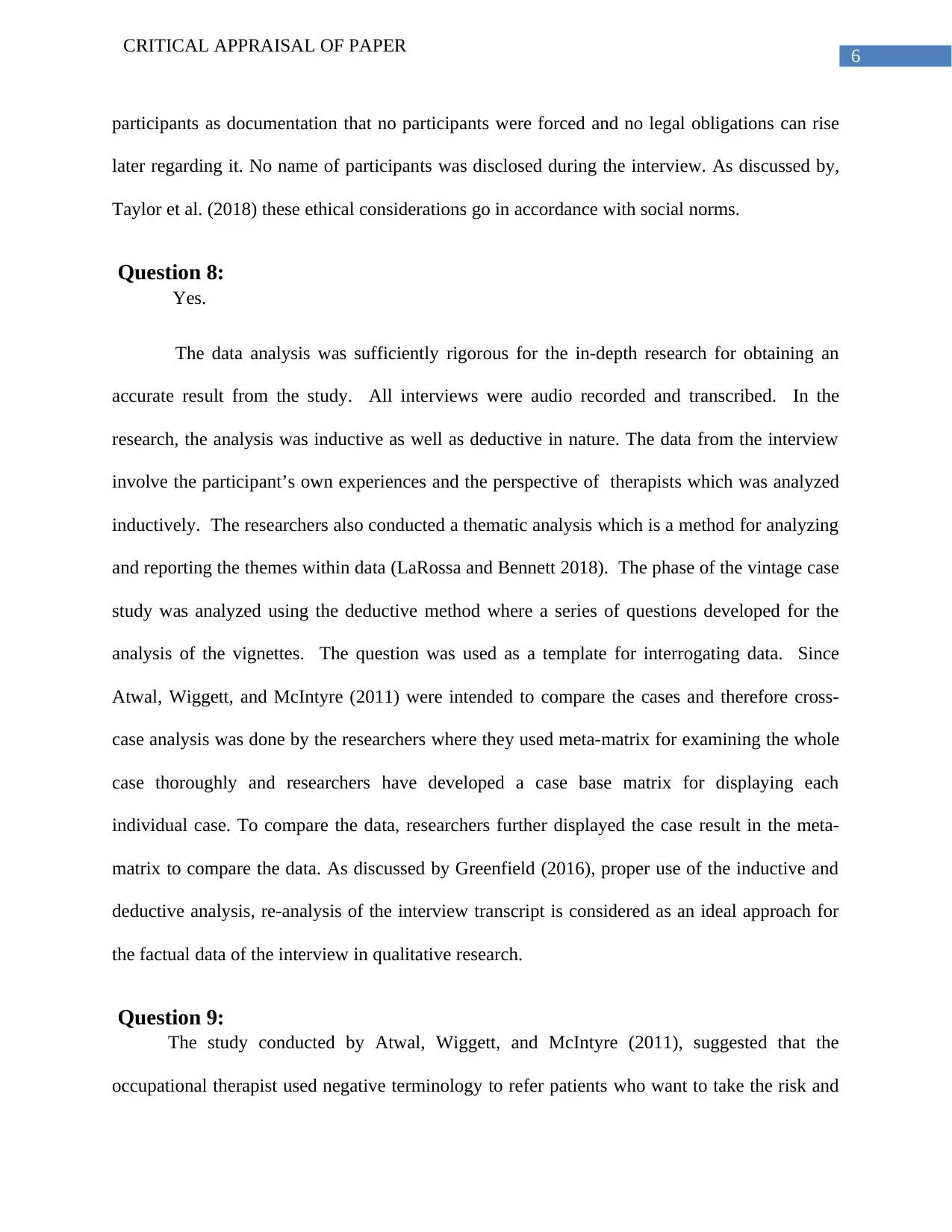
6
CRITICAL APPRAISAL OF PAPER
participants as documentation that no participants were forced and no legal obligations can rise
later regarding it. No name of participants was disclosed during the interview. As discussed by,
Taylor et al. (2018) these ethical considerations go in accordance with social norms.
Question 8:
Yes.
The data analysis was sufficiently rigorous for the in-depth research for obtaining an
accurate result from the study. All interviews were audio recorded and transcribed. In the
research, the analysis was inductive as well as deductive in nature. The data from the interview
involve the participant’s own experiences and the perspective of therapists which was analyzed
inductively. The researchers also conducted a thematic analysis which is a method for analyzing
and reporting the themes within data (LaRossa and Bennett 2018). The phase of the vintage case
study was analyzed using the deductive method where a series of questions developed for the
analysis of the vignettes. The question was used as a template for interrogating data. Since
Atwal, Wiggett, and McIntyre (2011) were intended to compare the cases and therefore cross-
case analysis was done by the researchers where they used meta-matrix for examining the whole
case thoroughly and researchers have developed a case base matrix for displaying each
individual case. To compare the data, researchers further displayed the case result in the meta-
matrix to compare the data. As discussed by Greenfield (2016), proper use of the inductive and
deductive analysis, re-analysis of the interview transcript is considered as an ideal approach for
the factual data of the interview in qualitative research.
Question 9:
The study conducted by Atwal, Wiggett, and McIntyre (2011), suggested that the
occupational therapist used negative terminology to refer patients who want to take the risk and
CRITICAL APPRAISAL OF PAPER
participants as documentation that no participants were forced and no legal obligations can rise
later regarding it. No name of participants was disclosed during the interview. As discussed by,
Taylor et al. (2018) these ethical considerations go in accordance with social norms.
Question 8:
Yes.
The data analysis was sufficiently rigorous for the in-depth research for obtaining an
accurate result from the study. All interviews were audio recorded and transcribed. In the
research, the analysis was inductive as well as deductive in nature. The data from the interview
involve the participant’s own experiences and the perspective of therapists which was analyzed
inductively. The researchers also conducted a thematic analysis which is a method for analyzing
and reporting the themes within data (LaRossa and Bennett 2018). The phase of the vintage case
study was analyzed using the deductive method where a series of questions developed for the
analysis of the vignettes. The question was used as a template for interrogating data. Since
Atwal, Wiggett, and McIntyre (2011) were intended to compare the cases and therefore cross-
case analysis was done by the researchers where they used meta-matrix for examining the whole
case thoroughly and researchers have developed a case base matrix for displaying each
individual case. To compare the data, researchers further displayed the case result in the meta-
matrix to compare the data. As discussed by Greenfield (2016), proper use of the inductive and
deductive analysis, re-analysis of the interview transcript is considered as an ideal approach for
the factual data of the interview in qualitative research.
Question 9:
The study conducted by Atwal, Wiggett, and McIntyre (2011), suggested that the
occupational therapist used negative terminology to refer patients who want to take the risk and
Paraphrase This Document
Need a fresh take? Get an instant paraphrase of this document with our AI Paraphraser
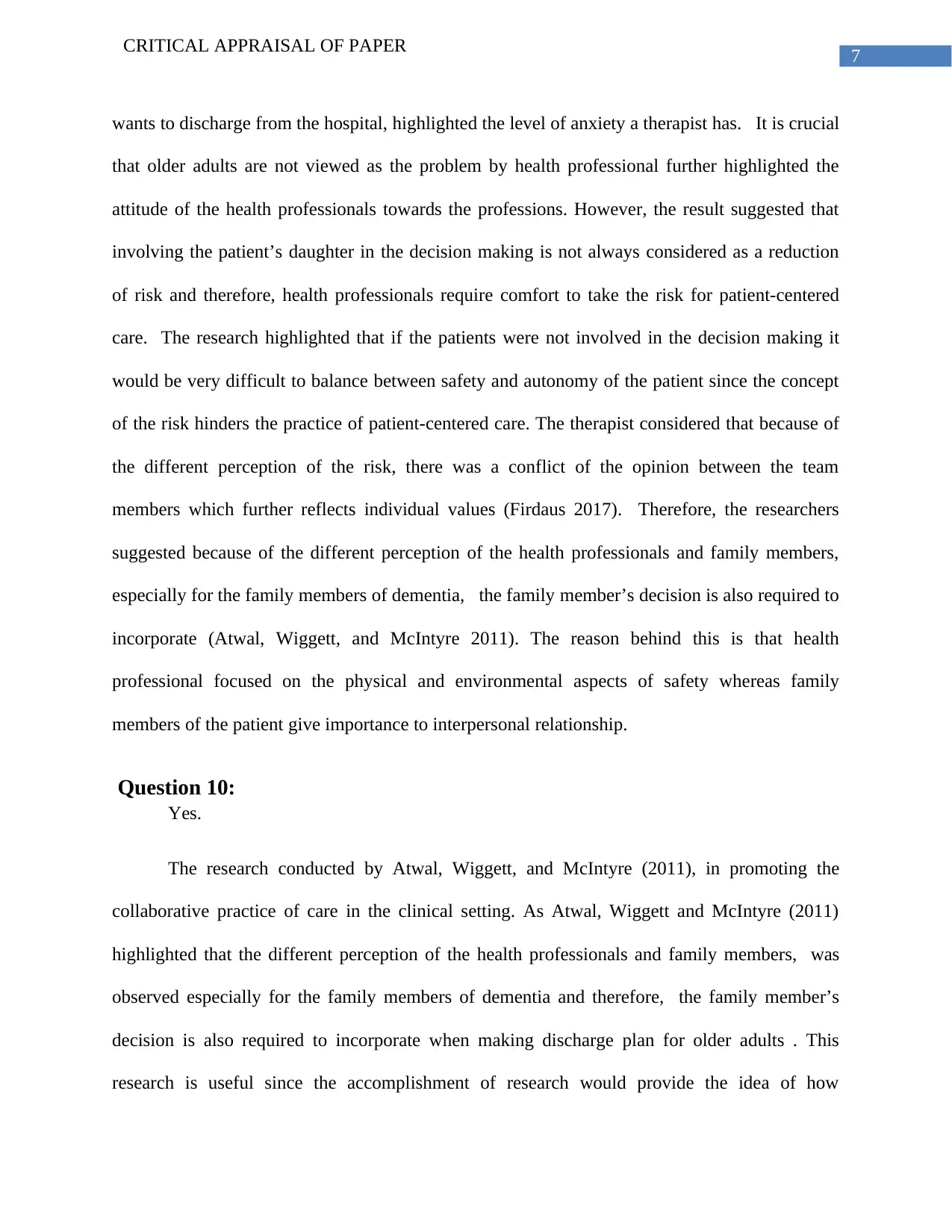
7
CRITICAL APPRAISAL OF PAPER
wants to discharge from the hospital, highlighted the level of anxiety a therapist has. It is crucial
that older adults are not viewed as the problem by health professional further highlighted the
attitude of the health professionals towards the professions. However, the result suggested that
involving the patient’s daughter in the decision making is not always considered as a reduction
of risk and therefore, health professionals require comfort to take the risk for patient-centered
care. The research highlighted that if the patients were not involved in the decision making it
would be very difficult to balance between safety and autonomy of the patient since the concept
of the risk hinders the practice of patient-centered care. The therapist considered that because of
the different perception of the risk, there was a conflict of the opinion between the team
members which further reflects individual values (Firdaus 2017). Therefore, the researchers
suggested because of the different perception of the health professionals and family members,
especially for the family members of dementia, the family member’s decision is also required to
incorporate (Atwal, Wiggett, and McIntyre 2011). The reason behind this is that health
professional focused on the physical and environmental aspects of safety whereas family
members of the patient give importance to interpersonal relationship.
Question 10:
Yes.
The research conducted by Atwal, Wiggett, and McIntyre (2011), in promoting the
collaborative practice of care in the clinical setting. As Atwal, Wiggett and McIntyre (2011)
highlighted that the different perception of the health professionals and family members, was
observed especially for the family members of dementia and therefore, the family member’s
decision is also required to incorporate when making discharge plan for older adults . This
research is useful since the accomplishment of research would provide the idea of how
CRITICAL APPRAISAL OF PAPER
wants to discharge from the hospital, highlighted the level of anxiety a therapist has. It is crucial
that older adults are not viewed as the problem by health professional further highlighted the
attitude of the health professionals towards the professions. However, the result suggested that
involving the patient’s daughter in the decision making is not always considered as a reduction
of risk and therefore, health professionals require comfort to take the risk for patient-centered
care. The research highlighted that if the patients were not involved in the decision making it
would be very difficult to balance between safety and autonomy of the patient since the concept
of the risk hinders the practice of patient-centered care. The therapist considered that because of
the different perception of the risk, there was a conflict of the opinion between the team
members which further reflects individual values (Firdaus 2017). Therefore, the researchers
suggested because of the different perception of the health professionals and family members,
especially for the family members of dementia, the family member’s decision is also required to
incorporate (Atwal, Wiggett, and McIntyre 2011). The reason behind this is that health
professional focused on the physical and environmental aspects of safety whereas family
members of the patient give importance to interpersonal relationship.
Question 10:
Yes.
The research conducted by Atwal, Wiggett, and McIntyre (2011), in promoting the
collaborative practice of care in the clinical setting. As Atwal, Wiggett and McIntyre (2011)
highlighted that the different perception of the health professionals and family members, was
observed especially for the family members of dementia and therefore, the family member’s
decision is also required to incorporate when making discharge plan for older adults . This
research is useful since the accomplishment of research would provide the idea of how
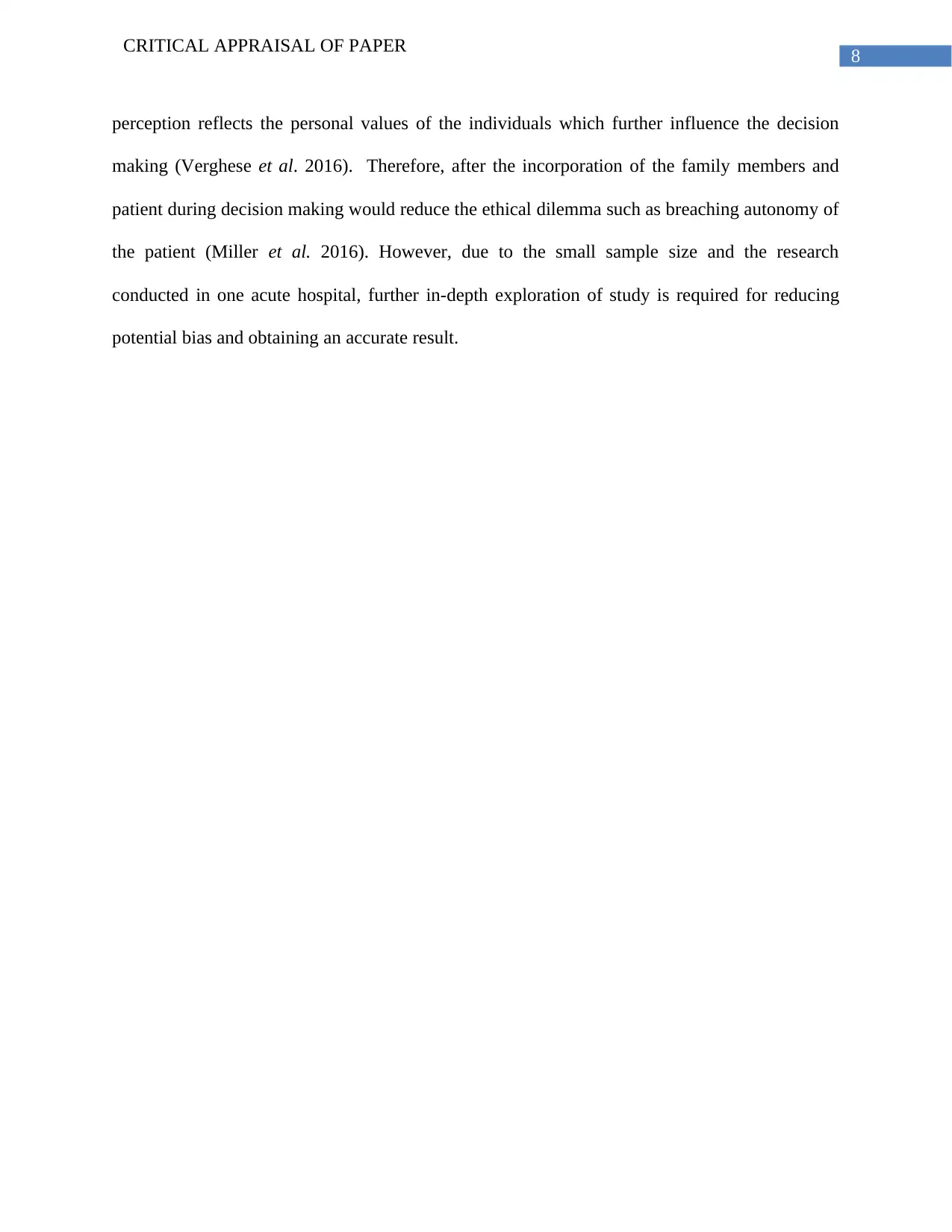
8
CRITICAL APPRAISAL OF PAPER
perception reflects the personal values of the individuals which further influence the decision
making (Verghese et al. 2016). Therefore, after the incorporation of the family members and
patient during decision making would reduce the ethical dilemma such as breaching autonomy of
the patient (Miller et al. 2016). However, due to the small sample size and the research
conducted in one acute hospital, further in-depth exploration of study is required for reducing
potential bias and obtaining an accurate result.
CRITICAL APPRAISAL OF PAPER
perception reflects the personal values of the individuals which further influence the decision
making (Verghese et al. 2016). Therefore, after the incorporation of the family members and
patient during decision making would reduce the ethical dilemma such as breaching autonomy of
the patient (Miller et al. 2016). However, due to the small sample size and the research
conducted in one acute hospital, further in-depth exploration of study is required for reducing
potential bias and obtaining an accurate result.
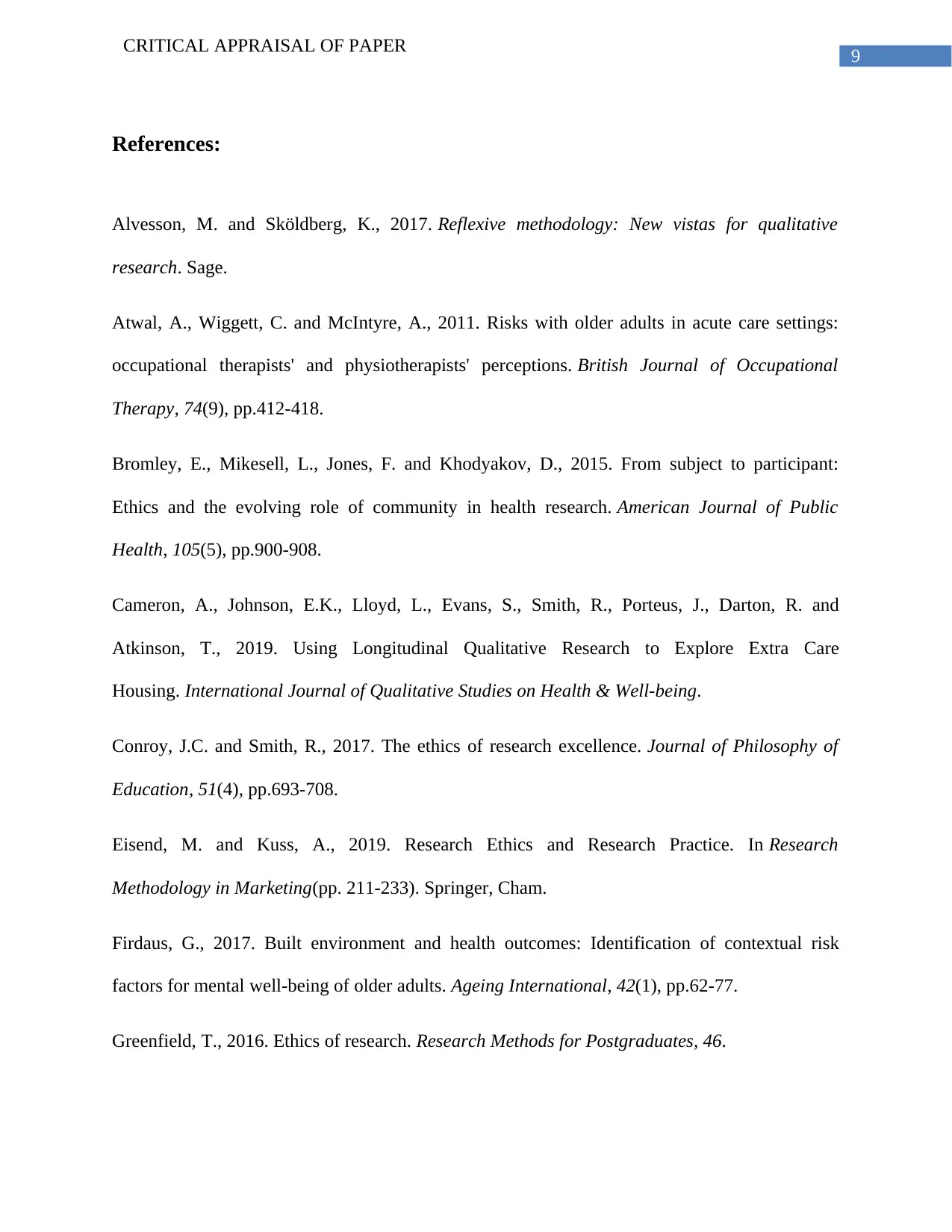
9
CRITICAL APPRAISAL OF PAPER
References:
Alvesson, M. and Sköldberg, K., 2017. Reflexive methodology: New vistas for qualitative
research. Sage.
Atwal, A., Wiggett, C. and McIntyre, A., 2011. Risks with older adults in acute care settings:
occupational therapists' and physiotherapists' perceptions. British Journal of Occupational
Therapy, 74(9), pp.412-418.
Bromley, E., Mikesell, L., Jones, F. and Khodyakov, D., 2015. From subject to participant:
Ethics and the evolving role of community in health research. American Journal of Public
Health, 105(5), pp.900-908.
Cameron, A., Johnson, E.K., Lloyd, L., Evans, S., Smith, R., Porteus, J., Darton, R. and
Atkinson, T., 2019. Using Longitudinal Qualitative Research to Explore Extra Care
Housing. International Journal of Qualitative Studies on Health & Well-being.
Conroy, J.C. and Smith, R., 2017. The ethics of research excellence. Journal of Philosophy of
Education, 51(4), pp.693-708.
Eisend, M. and Kuss, A., 2019. Research Ethics and Research Practice. In Research
Methodology in Marketing(pp. 211-233). Springer, Cham.
Firdaus, G., 2017. Built environment and health outcomes: Identification of contextual risk
factors for mental well-being of older adults. Ageing International, 42(1), pp.62-77.
Greenfield, T., 2016. Ethics of research. Research Methods for Postgraduates, 46.
CRITICAL APPRAISAL OF PAPER
References:
Alvesson, M. and Sköldberg, K., 2017. Reflexive methodology: New vistas for qualitative
research. Sage.
Atwal, A., Wiggett, C. and McIntyre, A., 2011. Risks with older adults in acute care settings:
occupational therapists' and physiotherapists' perceptions. British Journal of Occupational
Therapy, 74(9), pp.412-418.
Bromley, E., Mikesell, L., Jones, F. and Khodyakov, D., 2015. From subject to participant:
Ethics and the evolving role of community in health research. American Journal of Public
Health, 105(5), pp.900-908.
Cameron, A., Johnson, E.K., Lloyd, L., Evans, S., Smith, R., Porteus, J., Darton, R. and
Atkinson, T., 2019. Using Longitudinal Qualitative Research to Explore Extra Care
Housing. International Journal of Qualitative Studies on Health & Well-being.
Conroy, J.C. and Smith, R., 2017. The ethics of research excellence. Journal of Philosophy of
Education, 51(4), pp.693-708.
Eisend, M. and Kuss, A., 2019. Research Ethics and Research Practice. In Research
Methodology in Marketing(pp. 211-233). Springer, Cham.
Firdaus, G., 2017. Built environment and health outcomes: Identification of contextual risk
factors for mental well-being of older adults. Ageing International, 42(1), pp.62-77.
Greenfield, T., 2016. Ethics of research. Research Methods for Postgraduates, 46.
Secure Best Marks with AI Grader
Need help grading? Try our AI Grader for instant feedback on your assignments.
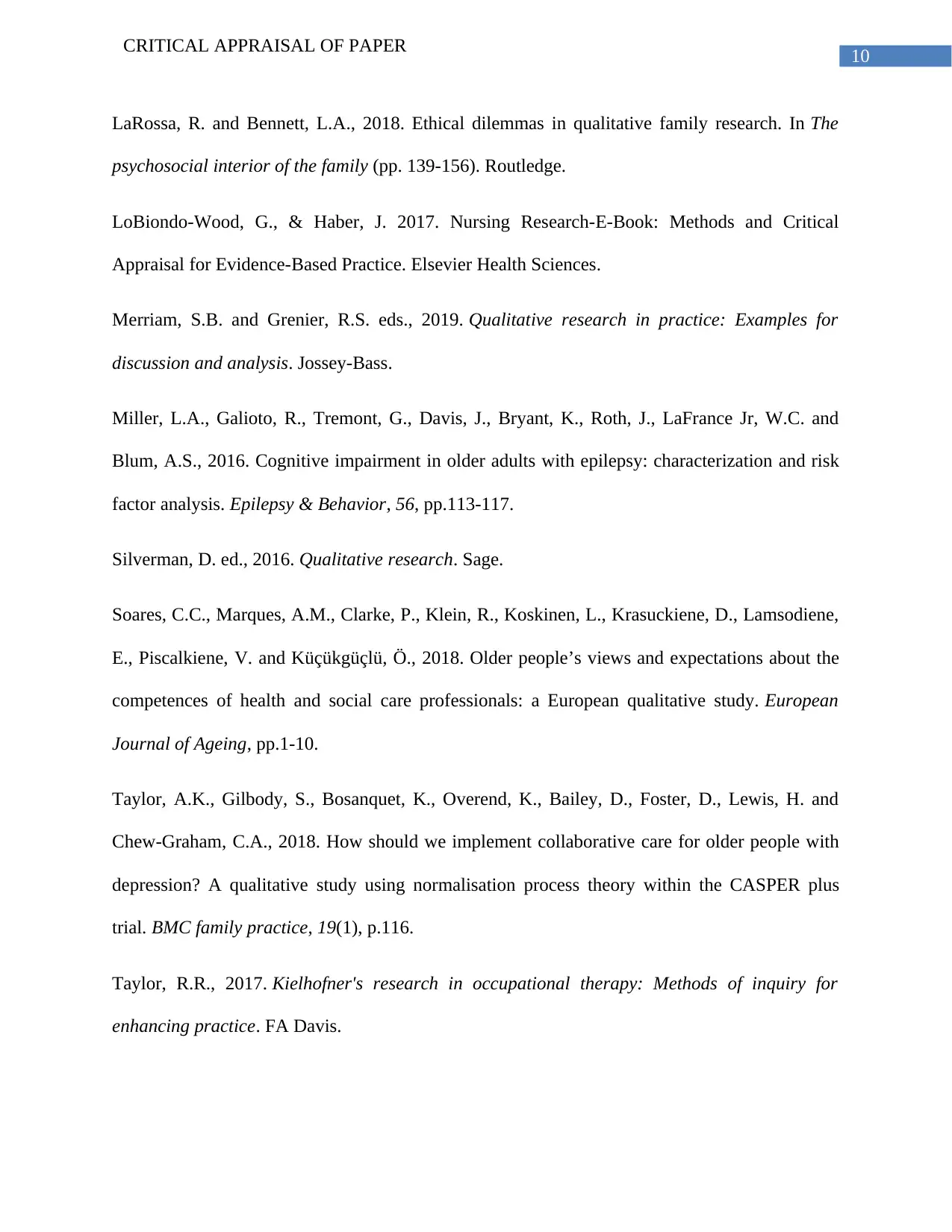
10
CRITICAL APPRAISAL OF PAPER
LaRossa, R. and Bennett, L.A., 2018. Ethical dilemmas in qualitative family research. In The
psychosocial interior of the family (pp. 139-156). Routledge.
LoBiondo-Wood, G., & Haber, J. 2017. Nursing Research-E-Book: Methods and Critical
Appraisal for Evidence-Based Practice. Elsevier Health Sciences.
Merriam, S.B. and Grenier, R.S. eds., 2019. Qualitative research in practice: Examples for
discussion and analysis. Jossey-Bass.
Miller, L.A., Galioto, R., Tremont, G., Davis, J., Bryant, K., Roth, J., LaFrance Jr, W.C. and
Blum, A.S., 2016. Cognitive impairment in older adults with epilepsy: characterization and risk
factor analysis. Epilepsy & Behavior, 56, pp.113-117.
Silverman, D. ed., 2016. Qualitative research. Sage.
Soares, C.C., Marques, A.M., Clarke, P., Klein, R., Koskinen, L., Krasuckiene, D., Lamsodiene,
E., Piscalkiene, V. and Küçükgüçlü, Ö., 2018. Older people’s views and expectations about the
competences of health and social care professionals: a European qualitative study. European
Journal of Ageing, pp.1-10.
Taylor, A.K., Gilbody, S., Bosanquet, K., Overend, K., Bailey, D., Foster, D., Lewis, H. and
Chew-Graham, C.A., 2018. How should we implement collaborative care for older people with
depression? A qualitative study using normalisation process theory within the CASPER plus
trial. BMC family practice, 19(1), p.116.
Taylor, R.R., 2017. Kielhofner's research in occupational therapy: Methods of inquiry for
enhancing practice. FA Davis.
CRITICAL APPRAISAL OF PAPER
LaRossa, R. and Bennett, L.A., 2018. Ethical dilemmas in qualitative family research. In The
psychosocial interior of the family (pp. 139-156). Routledge.
LoBiondo-Wood, G., & Haber, J. 2017. Nursing Research-E-Book: Methods and Critical
Appraisal for Evidence-Based Practice. Elsevier Health Sciences.
Merriam, S.B. and Grenier, R.S. eds., 2019. Qualitative research in practice: Examples for
discussion and analysis. Jossey-Bass.
Miller, L.A., Galioto, R., Tremont, G., Davis, J., Bryant, K., Roth, J., LaFrance Jr, W.C. and
Blum, A.S., 2016. Cognitive impairment in older adults with epilepsy: characterization and risk
factor analysis. Epilepsy & Behavior, 56, pp.113-117.
Silverman, D. ed., 2016. Qualitative research. Sage.
Soares, C.C., Marques, A.M., Clarke, P., Klein, R., Koskinen, L., Krasuckiene, D., Lamsodiene,
E., Piscalkiene, V. and Küçükgüçlü, Ö., 2018. Older people’s views and expectations about the
competences of health and social care professionals: a European qualitative study. European
Journal of Ageing, pp.1-10.
Taylor, A.K., Gilbody, S., Bosanquet, K., Overend, K., Bailey, D., Foster, D., Lewis, H. and
Chew-Graham, C.A., 2018. How should we implement collaborative care for older people with
depression? A qualitative study using normalisation process theory within the CASPER plus
trial. BMC family practice, 19(1), p.116.
Taylor, R.R., 2017. Kielhofner's research in occupational therapy: Methods of inquiry for
enhancing practice. FA Davis.
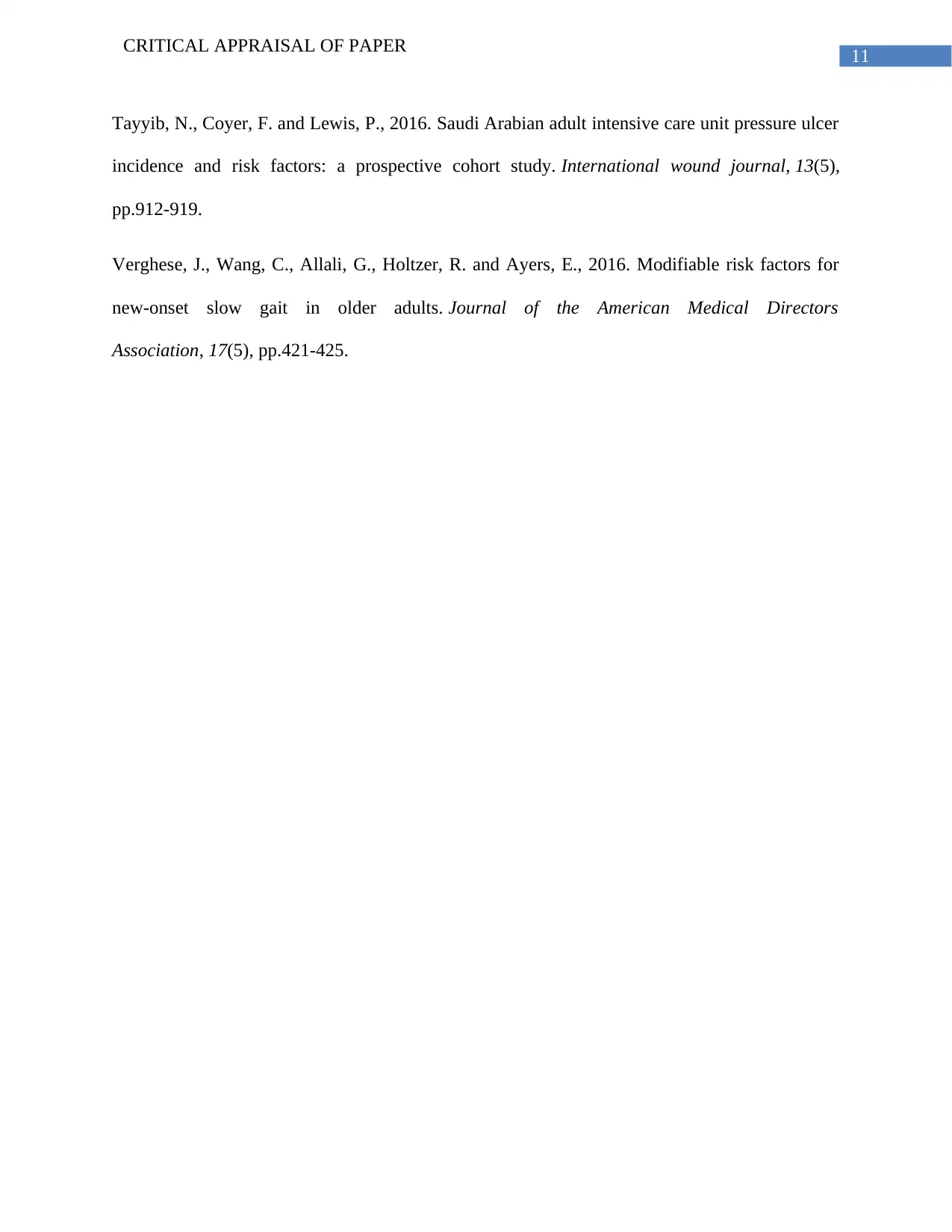
11
CRITICAL APPRAISAL OF PAPER
Tayyib, N., Coyer, F. and Lewis, P., 2016. Saudi Arabian adult intensive care unit pressure ulcer
incidence and risk factors: a prospective cohort study. International wound journal, 13(5),
pp.912-919.
Verghese, J., Wang, C., Allali, G., Holtzer, R. and Ayers, E., 2016. Modifiable risk factors for
new-onset slow gait in older adults. Journal of the American Medical Directors
Association, 17(5), pp.421-425.
CRITICAL APPRAISAL OF PAPER
Tayyib, N., Coyer, F. and Lewis, P., 2016. Saudi Arabian adult intensive care unit pressure ulcer
incidence and risk factors: a prospective cohort study. International wound journal, 13(5),
pp.912-919.
Verghese, J., Wang, C., Allali, G., Holtzer, R. and Ayers, E., 2016. Modifiable risk factors for
new-onset slow gait in older adults. Journal of the American Medical Directors
Association, 17(5), pp.421-425.
1 out of 12
Related Documents
Your All-in-One AI-Powered Toolkit for Academic Success.
+13062052269
info@desklib.com
Available 24*7 on WhatsApp / Email
![[object Object]](/_next/static/media/star-bottom.7253800d.svg)
Unlock your academic potential
© 2024 | Zucol Services PVT LTD | All rights reserved.



